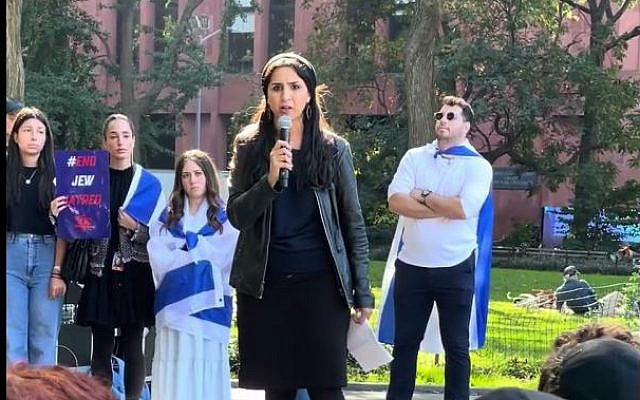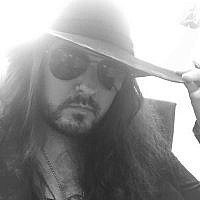US Jewry can look to Esther as a role model

Is America the new Shushan?
This question startled me when I heard it last week.
Since October 7th, I have been obsessively going back to Jewish memory to help me understand where I am. Which elements of this moment echo which era and place? Which survival strategies from our past can guide us? I know I’m not alone in this memory work: this is what we Jews do. We pick at the scabs of our generational trauma; we become history detectives hunting for clues to tell us how to go on.
So, are we in Haman’s Shushan? Much of our conversation in our communities rightly focuses on rising antisemitism — maybe the end of a golden age for both America and its Jews. Poll after poll gives credence to this sentiment — whether they are illustrating Jews’ own sense of rising antisemitism or showing the rise in unfavorable opinions of Jews.
But despite the undeniable and worrying rise in antisemitism, we should acknowledge that, thank God, thus far, we have been spared the despair of Haman’s Shushan. Not only are we far from the vulnerability of Shushan’s Jews, but also the animosity against Jews in America more closely resembles the hostility of another Jewish holiday, Hanukkah.
That does not mean we are not facing existential threats — I believe we are. To emerge victorious, we must carefully analyze our challenges and adversaries. And then we must take them on, with faith and courage, transforming into a new generation of “Esthers.”
* * *
The Purim Paradigm of Jew-Hatred: Haman’s Totalizing Antisemitism
The depiction of Jew-hatred in the story of Shushan, exemplified by Haman’s fervent animosity, encapsulates a particularly insidious form of antisemitism rooted in the essentialization of Jews. This essentialization perceives all Jews as possessing fixed and inherent characteristics. This kind of antisemitism vilifies and demonizes all Jews indiscriminately. It is hatred that knows no bounds, disregarding individual Jewish beliefs and practices, or lack therefore. All Jews become legitimate targets. Haman’s aim was the total annihilation of every Jew.
Such totalizing hatred found its most horrific historical manifestation in Nazi Germany’s racial antisemitism, where just having one Jewish grandparent condemned individuals as subhuman. There was no escaping the Nazis, no bargains to be made, no Judaism to be renounced as the price of survival.
We saw this same hatred unleashed on October 7th, when Hamas terrorists, driven by ideologies akin to Haman’s, wielded power. We saw and heard this hatred: the bloodthirst and frivolity while committing war crimes, the gleeful and genocidal phone calls of terrorists to their parents, proudly noting how many Jews they had killed. They said nothing about their dreams of a Palestinian state; they spoke only of how many “yahuds” they had slaughtered. And they targeted anyone they associated with the Jewish state: anti-occupation peace activists from kibbutzim and religious Zionist Jews who grew up in settlements; Jews, Christians, and Muslims.
This hatred of all Jews has been rekindled around the world, from Iran to Tunisia to Dagestan. This, we remember, is the hatred of Shushan’s Haman, the paradigm of Purim.
We have certainly seen the rise of this kind of hatred in America: the rise of swastikas graffitied on synagogues; the anti-Israel protests where Heil Hitler salutes abound; the social media messages telling us Jews that we don’t deserve life and dignity; violence against visibly religious Jews; open antisemitism in public schools. Yes, we are hiring more security guards, and too many of us are, for the first time, worrying about visible signs of our Jewishness.
But we are still — thank God — far from Haman’s Shushan. Our government and police forces want to protect us. Most in the American mainstream, from progressive activists and politicians (yes, even the Squad) to campus professors to corporate financiers, pay at least lip service to denouncing antisemitism. Jews do face rising threats, but not that of annihilation. Rather, an adjacent creeping threat is assaulting our lives and belief systems. In liberal environments where we have felt most at home in America — in our workplaces, on our campuses, and in our streets, too many will target not all Jews indiscriminately but a specific set of Jewish beliefs and practices. It is a persecution of Judaism, rather than of Jews.
Seleucid Greeks Hated the Maccabees’ Judaism
So too the Hanukkah story. The Seleucid Greeks did not try to kill the Jewish people, but were opposed to what they perceived as an antiquated Judaism, one at odds with Hellenistic civilization. They aimed not for Jewish extinction, but for a transformation, urging Jews to forsake their Temple-centered practices and what they deemed “barbaric” customs like circumcision.
The Jew-hatred of the Seleucid Greeks disdained classical Judaism and all who adhered to it, but they welcomed Hellenized Jews — those who embraced the refined, Hellenized version of Judaism championed by the Maccabees’ adversaries.
The Jews of the time had to choose: be “good Jews” (in the lexicon of the oppressor) and renounce the despised elements of their faith, or remain steadfast as “bad Jews,” upholding the demonized doctrine.
Today, the primary challenge we confront in liberal America is mounting pressure to renounce our Judaism, which cannot be disentangled from our relationship with Israel or our bonds to Jews around the world, including 7 million living in Israel. In my conversations with hundreds of Jewish college students, the same theme has come up time and again: intense social pressure from friends and professors who talk of Israel and Zionism as the ultimate evil, coupled with intense pressure to dehumanize Hamas’s Israeli victims as undeserving of empathy. Indeed, a concerted international effort is vilifying Israel by associating it with the gravest crimes of the 20th century: colonialism, genocide, and apartheid.
Let’s be clear here: those who demonize Israel (and I exclude here those who critique it) are adopting a playbook reminiscent of the Seleucid Greeks’ hatred of Judaism. They attempt to absolve themselves of guilt by citing Jewish acquaintances and championing groups like Jewish Voices for Peace (JVP) and IfNotNow (INN), modern-day “good Jews” in their eyes. They will point to Jonathan Glazer’s Oscar speech to substantiate their claims — a director who has earned himself a place in the annals of Jewish history as a “good Jew” having little to do with Jews or Judaism, whom generations of Jews will remember, long after the Oscars become relics of an antiquated past.
I am not, of course, talking about those who critique Israel or non-Zionist Jews. I am also not demanding we agree on the contours of each others’ Judaism. I am referring specifically to those who publicly and loudly make use of their identity as Jews towards a pathological demonization of Israel, in partnership with those who hate most Jews’ Judaism, one inextricably intertwined with Israel. Those in America who demonize Israel and dehumanize Israelis immensely want the support of these “good Jews,” for even as they effectively wage war against Judaism, they can deny accusations of antisemitism.
Recognizing that we liberal American Jews are confronting immense pressure to subsume our Judaism is vital. It must awaken our courage and strength to confront the societal pressure to suppress our allegiance to Israel.
In this context, even on Purim, we must recall the Maccabees’ unwavering resolve. They fought not merely for survival, but to assert their Jewish identity, safeguarding the dignity and legitimacy of Judaism itself.
This is our battle, our war to wage.
Today: Transforming into Esthers
Even as Jews around the world face distinct threats, there is a shared consciousness that connects us. Our social-media-powered reality means that we Jews in New York experience and respond to our local challenges aware of the threats that Jews in Sderot or London, face, blurring the lines between the narratives of Purim and Hanukkah in our hearts and minds.
But even as it is useful to understand ourselves through the prisms of Purim and Hanukkah, we should avoid oversimplifying comparisons between historical and contemporary adversaries. Haman’s overwhelming power is starkly different — thank God — from brutal terror groups like Hamas. Comparing the hatred of contemporary American anti-Israel activists with the ancient Seleucid Empire should not obscure the obvious differences between them.
So too, the dangers we face today in America and in Israel are different. This does not mean that we who recognize of the dangers of Hanukkah’s threat — a war against our Judaism in liberal America — should be too assured that we won’t see this hatred metastasize into essentializing antisemitism: hatred of all Jews and violence against all Jews.
But it means that we must name the war we are facing, and recognize hatred that pressures us into renouncing our Judaism or going with it underground. Canceled concerts and canceled campus speakers are just the tip of the iceberg.
My work with Jewish college students and young professionals in The Downtown Minyan has given me (and so many) a window into trends that will only grow. Students who stay silent while professors decry Israel’s crimes (in classes unrelated to the matter and with students’ grades on the balance), friends who post daily about Israel’s presumed genocide and who condemn those who espouse pro-Israel views, colleagues who hijack offices’ Slack channels to promote protests whose flavor is decidedly pro-Hamas… We cannot operate under the illusion that the campus climate won’t persist outside the ivory towers. As social commentator Andrew Sullivan noted already in 2018, we all live on campus now. Trends that manifest most extremely on campus expand to the rest of our society.
I have therefore been inspired by the amazing awakening of so many Jews who speak up proudly about their Judaism: their practices, their solidarity, and their belief system, their insistence on the humanity of their Israeli extended family.
But for every Jew who is proudly standing tall for a Judaism intertwined with Israel, I think of those who stay quiet. I think of the very human impulse to cower under threat and hide oneself. I speak even of myself.
I have walked past protests in my neighborhood and struggled with how much to wear my Judaism and love for Israel on my sleeve. I have debated whether my 7-year-old should wear his kippa on certain subway lines. I have spoken at too many Israel-focused events where the organizers (rationally) asked that they be kept private, with vetted attendance, to prevent protesters — gatherings that in the past would have been loudly advertised. I sense a growing fear that the pressures on Jews to hide who we are and the Judaism we stand for – in exchange for that seductive elixir of acceptance — are potent indeed.
But this price for acceptance is intolerable. Purim invites us to recommit to fighting with all our might to live as proud American Jews, inheritors of a Judaism where Zion has always, always, been the focus of our most fervent prayers.
To do so, we must embody the spirit of Esther.
Esther is an unexpected heroine. She is not described as a proud Jewess; she hides her identity. She is disconnected from her people, not even knowing about the genocidal decree against them until her uncle tells her. She does not see herself as powerful, but describes herself as a pawn to her (murderous) king-husband.
Esther symbolizes the way too many Jews feel today — confronted by rising hatred against their Judaism, they feel scared, passive, and demoralized. But by the end of the Purim story, Esther transforms from pawn to queen, object to subject, crypto to proud Jew.
What gives Esther strength is Mordechai’s challenge to expand her imagination of what could be – to visualize salvation as possible. Mordechai invites Esther to see herself as capable of standing up to Haman. Mordechai promises his niece that she has within her strengths and depths that she cannot imagine.
And Esther begins to see herself as part of the tapestry of Jewish history, and picks up its mantle. She has no false illusions about her own safety or success, and she knows she needs spiritual fellowship to bolster her courage. She asks all the Jews to fast and pray for her while she prepares to go before the king. Esther might be unable to change Haman and his hatred, but she can change herself. No longer a passive ruler with no agency; she is a warrior queen.
Esther’s story guides us because she reminds us that we are stronger than we think we are. We can transform ourselves by resisting the urge to hide our Judaism.
American Jews have begun to use their voices, votes, and resources to fight Jew-hatred. Jewish life is continuing — thank God — in full force, with religious gatherings, conferences, and rallies. We can transform — from a community that took its place in the world for granted to an American Jewry, bravely fighting for its Judaism.



